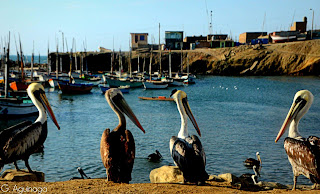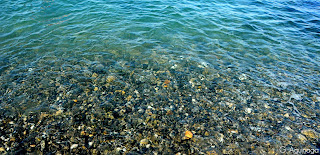An Island In The Middle
Its strategic location at the Eastern Pacific turns it into a peculiar shelter.
Photographs by Giuseppe Aguinaga.
PAITA, Peru - It seems to be a stone-&-sand berg from La Islilla Beach, a huge natural breakwater keeping a fishers cove on the southwestern side of La Silla de Paita (The Paita's Chair, approximately 350 meters or 1150 feet altitude). However, it is a natural milestone of two big marine ecosystems for the science.
Foca
Island is far the South-American continent just 800 meters or half a mile to
1 kilometer or 0,6 miles of water, and according to the book Piura, Áreas prioritarias para la conservación de la
biodiversidad (Piura - Priority Areas For Conserving the Biodiversity),
edited by Nature and
Culture International (NCI) in 2014, is an extension of the Peruvian
desert, an arid land reaching to penetrate into Chile toward the south, and
the half of Tumbes Region at the north.
It is about 92 hectares or 227
acres, what allow it to contain loosely two Vatican Cities. Its highest point is
50 meters or 164 feet, seven times higher than Paita City, which
it depends administratively on, gotten away 20 km or 12 miles to the
south.

It could seem to be a plateau elevating abruptly out from the sea bottom, judging the cliffs mostly surrounding it. Its few beaches are mainly upholstered by sedimentary rocks and boulders.
El Itsmo (The Itsmus) is in the middle of the island, a sort of cleavage running from west to east, and the sea bottom is not very deep around it, instead a prairie of green seaweeds called caulerpas, also reefs and sand bottoms. According to NCI, "tey establish a shelter of the whole undermarine fauna."
Piura-wide, it is not only at its central coast but apparently on the center of its coast. Peru-wide, it is the northern island along its whole sea. But worldwide, it seems to be in the middle of something much greater.
As we told it previously, two big oceanic currents meet in front of Piura, Humboldt's contributing with Antarctic cold water, and El Niño bringing equatorial warm water on. That causes two ecosystems, respectively: The Cold Sea or Temperate Eastern Pacific Sea, running along Chile Coast to Punta Aguja (Sechura), and The Tropical Sea or Tropical Eastern Pacific Sea, starting in the Gulf of California (Mexico) and ending in Cabo Blanco (El Alto, Talara).
Due to the projection itself of South America to the west, precisely in Piura, The Tropical Sea as well as The Cold Sea do not have a defined dividing limit, but they mix around in a kind of transition zone between Punta Aguja and Cabo Blanco, and Foca Island is just in the middle of what is known as Temperate-Tropical Sea, and also it shares the oriental vertex of all that transition zone with La Islilla. In fact, according to NCI, that is the only island across the Eastern Pacific Ocean, located in a zone of that kind.
In other words, it has the best of Humboldt's and the best of El Niño's. While the first current is rich in nutrients (plancton) and trends to drown because of a thermic effect (the cold water is denser because the molecules are most cohesive), the warm one locates more at the surface of the sea, although it do not contribute with much nutrients.
As a result, we have a combined biodiversity of both ecosystems, although that determines by the predominance of each current according to the season of the year (more Humboldt in the winter, more El Niño in the summer).

"Beneath the water of this island, live proper species of the Peruvian Current as well as species of tropical water, those can be found at the Gulf of California or Galápagos Islands," NCI points out. And this riches attracts on the land a varied fauna, even turtles. The bad news - many ones are in extinction peril or are still unknown by the science.
Also on and over the land, birds such as Humboldt penguin (Spheniscus humboldti), the Peruvian booby (Sula variegata), and the red-legged cormorant (Phalacrocorax gaimardi) have the north boundary of their habitat on the island. The Peruvian storm petrel (Oceanodroma tethys kelsalli), also, has selected it as its few breeding areas.
"The presence of these species justify Foca Island to be recognized internationally as an important area for the birds conservation," NCI stressed out in 2014, so it included that into a proposal for a marine-coastal area of conservation in 2016, with two biospaces of Piura Region and one another of Tumbes Region.
Lately, that proposal only has favorable opinion of Congress of Peru's Commission of Andean, Amazonian, and African-Peruvian People, and Ecology and Environment, but it needs to go up to the whole parliament, then its promulgation to be requested to the Peru's Presidency.
If that is not enough, Foca Island is still the home of a scientific controversy about the origin of the south-American fur Seals (Arctocephalus cf. australis) living there. It is suspected could be the Galápagos fur seal (A. galapagoensis). The issue is still under investigation and the science only will say us if it is about the austral species or the tropical species, or maybe a hybrid that has been adapting to the island.
Until learning it, the tourism has been suggested as a complementary activity to the fishing already made from La Islilla, what also could make a circuit with La Silla de Paita, only if it develops into a sustainable way. Currently, the people who already visited it left pretty fascinated. The choices, in every sense, are just beginning to explore.

Many of the species living around Foca Island are in the red list of the International Union for Conservation of Nature - extinction peril, or threatened.
BREAKING FILE OF FOCA
island
referential
Coordinates:
North Edge: 5° 04’
S
West Edge: 81° 14’ W /
South Edge: 5° 21’
S
East edge: 81° 09’
W
Remarkable
Biodiversity
Fishes:
Lowfin moray(Gymnothorax porphyreus)
Brick seabass (Acanthistius pictus)
Broomtail grouper (Mycteroperca xenarcha)
Peruvian rock seabass
(Paralabrax humeralis)
Cortez Angelfish (Pomacanthus zonipectus)
Coquito damsel or coquito
sergeant (Nexilosus latifrons)
Acapulco major, Acapulco
damselfish or Acapulco gregory (Stegastes
acapulcoensis)
Peruvian morwong (Cheilodactylus variegatus)
Giant blenny (Scartichthys gigas)
Marine
Invertebrate
Gould octopus (Octopus mimus)
Rabbitnose shrimp (Rhynchocinetestypus)
Starfish (Stichaster striatus)
Sunstar (Heliaster helianthus)
Western spinny brettle star
(Ophiothrix spiculata)
Green sea urchin (Lytechinus semituberculatus)
Brown sea cucumber (Isostichopus fuscus)
endemic,
threatened birds:
Humboldt penguin (Spheniscus humboldti)
Peruvian storm petrel
(Oceanodroma tethys kelsalli)
Peruvian pelican (Pelecanus thagus)
Peruvian booby (Sula variegata)
guanay cormorant (Phalacrocorax bougainvillii)
Grey gull (Leucophaeus modestus)
Belcher's gull or bandtail
gull (Larus belcheri)
Inca tern (Larosterna inca)
Oystercatcher (Haematopus ater)
Red-legged cormorant (Phalacrocorax gaimardi)
- During the summer, it is possible to watch neo-tropical migrant birds as the ruddy turnstone (Arenariainterpres) and the wandering tattler (Tringa incana).
Mammals:
South-American sea lion
(Otariaflavescens)
Humpback whale (Megaptera novaeangliae)
South-American fur seal
(Arctocephalus cf. australis)
- Ocassionally, the California sea lion (Zalophus californianus) and some species of dolphins are watched in the sea.
endemic
Reptiles of the Peruvian Coast:
Peru Pacific iguana (Microlophus peruvianus)
Central-toed gecko (Phyllodactylus microphyllus)
Highlighted
Reptile:
Green turtle (Chelonia mydas).








Comentarios
Publicar un comentario